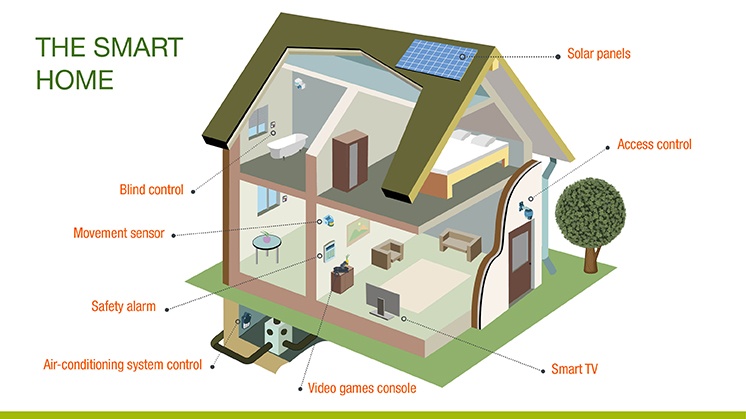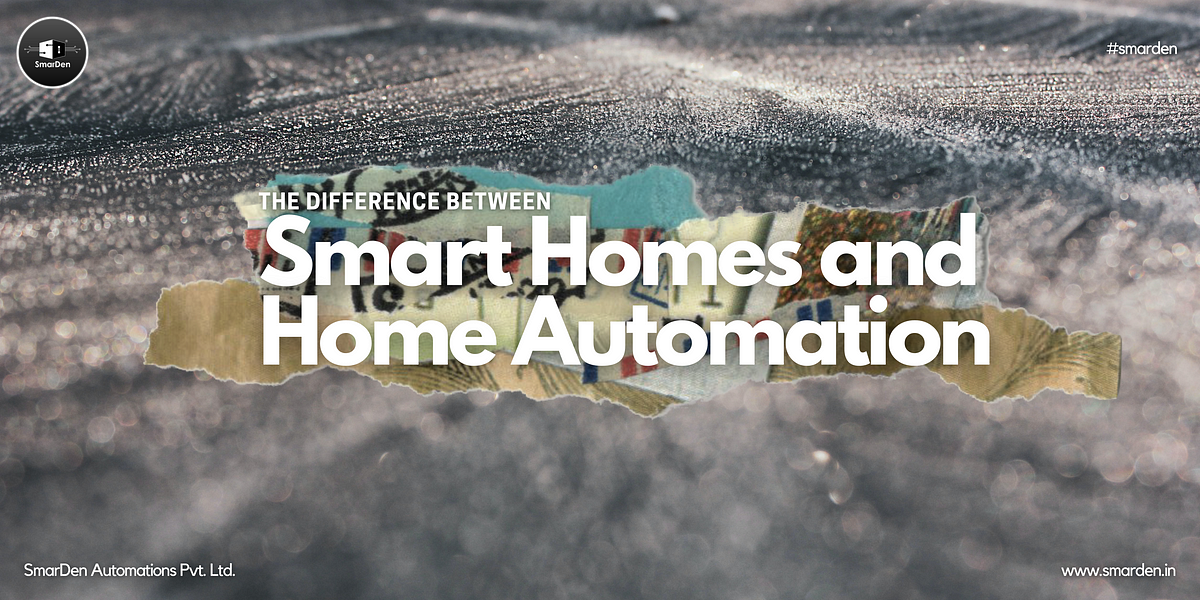Smart home refers to the integration of various devices and systems for enhanced convenience and efficiency within a home. Home automation, on the other hand, focuses on the automatic control of home features such as lighting, temperature, and security.
Smart home encompasses a broader range of interconnected technologies, including voice assistants and smart appliances, while home automation typically centers on specific functions like automated lighting or thermostat control. Both concepts share the goal of streamlining tasks and improving energy efficiency, but smart home solutions offer a more comprehensive approach to modernizing the home environment.
As technology continues to advance, these terms are often used interchangeably, highlighting the seamless integration of automation into everyday life.
Introduction To Smart Home And Home Automation
Smart home technology and home automation are often used interchangeably, but there is a subtle difference between the two. Smart home refers to a system where various devices and appliances are connected and can be controlled remotely, while home automation focuses on automating tasks within the home, such as lighting and temperature control.
Concepts Defined
A smart home and home automation are two terms often used interchangeably, but they have distinct differences. Understanding these differences is crucial for anyone looking to integrate advanced technology into their living space.
A smart home refers to a residence equipped with various devices and systems that can be controlled remotely or automated to perform tasks without the need for manual intervention. This includes smart lighting, thermostats, security systems, and entertainment systems.
On the other hand, home automation encompasses the technology that enables automatic and centralized control of household appliances and features. This can include automated blinds, smart locks, and automated irrigation systems.
While both concepts revolve around leveraging technology for convenience and efficiency, it’s important to recognize the nuances that set them apart.
Technological Evolution
The evolution of smart home and home automation technologies has significantly transformed the way we interact with our living spaces. From basic programmable thermostats to interconnected systems that can be managed through voice commands and mobile apps, the advancements in this field have revolutionized the concept of home management.
The integration of artificial intelligence and machine learning has further enhanced the capabilities of smart home and home automation systems, enabling them to learn user preferences and adapt to individual behavior patterns. As technology continues to advance, the potential for creating truly intelligent and intuitive living environments becomes increasingly attainable.
Core Principles Of A Smart Home
Smart homes are revolutionizing the way we interact with our living spaces. Understanding the core principles of a smart home is essential to grasp the concept fully. Let’s delve into the fundamental aspects that define a smart home.
Connectivity
Connectivity is the backbone of a smart home. It enables devices to communicate and interact seamlessly. From lights to thermostats, connected devices form a network that can be controlled remotely.
Interoperability
Interoperability is key to a smart home ecosystem. It ensures that different devices from various manufacturers can work together harmoniously. This compatibility enhances the user experience.
User Experience
User Experience is at the forefront of smart home design. It focuses on making the interaction between the user and the technology intuitive and efficient. A well-designed smart home prioritizes user convenience and simplicity.
Fundamentals Of Home Automation
Home automation is the concept of using technology to automate the operations of a house. It involves the use of various devices and systems to control the temperature, lighting, security, and entertainment systems. Home automation has become increasingly popular in recent years, and many people are now looking to upgrade their homes with smart devices and automation technology.
Automation Technology
The technology used for home automation can vary depending on the specific needs of the homeowner. Some common technologies used for home automation include:
- Wi-Fi
- Zigbee
- Z-Wave
- Insteon
Systems And Protocols
Home automation systems and protocols are used to manage the various devices and systems in a home. These systems and protocols include:
- Smart hubs
- Voice assistants
- Sensors
- Smart thermostats
- Lighting systems
- Security systems
Overall, home automation is a rapidly growing industry that is changing the way we live in our homes. With the use of automation technology and systems, homeowners can enjoy a more comfortable and convenient living experience.
Comparing Smart Home And Home Automation
Functionality And Control
The functionality and control of smart home and home automation systems differ in their approach. Smart home technology focuses on integrating various devices and systems to provide a seamless user experience. This includes the ability to control and monitor different aspects of the home, such as lighting, security, climate, and entertainment, through a centralized platform or mobile application.
On the other hand, home automation typically involves the automation of specific tasks or processes within the home environment. This may include setting up automated schedules for lighting, thermostats, and appliances, but may not always offer the same level of integration and flexibility as a full smart home system.
Complexity Levels
The complexity levels of smart home and home automation solutions can vary significantly. Smart home systems often require a more extensive setup process, involving the installation and configuration of multiple devices and sensors throughout the home. Additionally, integration with other smart devices and platforms may add to the complexity of the setup.
Home automation, on the other hand, can range from simple plug-and-play solutions to more advanced systems that may require professional installation and programming. While some home automation solutions may offer a more straightforward setup process, the level of customization and integration with other devices and systems may be more limited compared to a full smart home setup.
The Ecosystem Of Smart Home Devices
Popular Devices
In a smart home ecosystem, the devices and gadgets work together seamlessly to create a connected and automated living space. Popular devices include smart thermostats, security cameras, smart lighting, voice assistants, and smart locks. These devices are designed to enhance convenience, security, and energy efficiency within the home.
Integration Challenges
One of the significant challenges in smart home ecosystems is the integration of different devices from various manufacturers. Compatibility issues can arise, leading to difficulties in creating a cohesive and functional system. Manufacturers are working to address these challenges by developing universal standards and protocols for seamless integration.
Home Automation Systems In Action
Home automation systems offer convenience by allowing control of various devices remotely. The key difference lies in smart homes being a subset of home automation, focusing more on interconnectivity and user-friendly interfaces for a seamless experience.
Scene Creation
Creating a scene is one of the most significant features of home automation systems. A scene is a pre-set configuration of multiple smart devices that work together to perform a specific task. For instance, a “movie scene” can dim the lights, close the curtains, and turn on the TV and sound system with a single command. Similarly, a “morning scene” can turn on the lights, open the curtains, and start brewing coffee. With scene creation, you can control multiple devices simultaneously, making your life more comfortable and convenient.Energy Management
Home automation systems also help in managing energy consumption. With the help of smart devices, you can monitor and control your energy usage. For instance, you can set your thermostat to turn off when you’re not at home, or you can turn off the lights automatically when you leave the room. These simple actions can significantly reduce your energy bills and help you contribute to a greener environment.Remote Access
Another essential feature of home automation systems is remote access. With a smartphone or tablet, you can control your smart devices from anywhere in the world. For instance, if you forget to turn off the lights or lock the door, you can do so remotely. You can also monitor your home security cameras and receive notifications in case of any suspicious activity.Security
Home automation systems provide an added layer of security to your home. With smart security cameras, door locks, and motion sensors, you can monitor your home’s safety and receive alerts in case of any unusual activity. You can also set up rules to turn on the lights automatically when someone enters the room or trigger an alarm when someone tries to break in. In conclusion, home automation systems are not just a luxury but a necessity in today’s fast-paced world. With the ability to control multiple devices simultaneously, manage energy consumption, and enhance security, home automation systems have become an integral part of modern living. So, if you’re looking for a smarter and more comfortable home, consider investing in a home automation system today!User Interaction And Control Interfaces
When it comes to smart homes and home automation, user interaction and control interfaces play a crucial role in enhancing the overall experience.
Voice Control
Voice control allows users to command devices verbally, making it convenient and hands-free.
Mobile And Web Apps
Mobile and web apps provide users with the flexibility to control their smart devices remotely.
:max_bytes(150000):strip_icc()/smart-home.asp-final-5de0da3d6d8a474f9028d26c957255fe.png)
Credit: www.investopedia.com
Future Trends In Smart Home And Automation
The future trends in smart home and automation are shaping the way we interact with our living spaces. Advancements in technology have led to the integration of artificial intelligence and predictive behaviors, revolutionizing the concept of home automation.
Artificial Intelligence
Artificial intelligence (AI) plays a pivotal role in the evolution of smart homes and automation. AI enables devices to learn from user behaviors, adapt to preferences, and anticipate needs, enhancing the overall home experience.
Predictive Behaviors
Predictive behaviors empower smart home systems to anticipate and respond to the needs of occupants. These systems use data analysis to forecast preferences, adjust settings, and provide a seamless and personalized environment.
Security And Privacy Concerns
Security and privacy concerns differ between smart home and home automation systems. Smart homes focus on user convenience and interconnectivity, while home automation emphasizes remote control and energy efficiency. Both require robust security measures to protect personal data and ensure privacy.
Data Protection
Ensuring data protection in smart homes requires robust security measures.
Secure Network Practices
Implement secure network practices to safeguard personal information from cyber threats.
Security and Privacy Concerns Smart Home and Home Automation differ in security and privacy concerns. Data Protection Data protection in smart homes is critical for safeguarding personal information. Ensure robust security measures to protect sensitive data. Secure Network Practices Implementing secure network practices is essential to prevent cyber attacks. Maintain a secure network to safeguard against unauthorized access. Protecting privacy and securing data are paramount in smart home technology.Making The Right Choice For Your Home
Smart home technology enables devices to communicate with each other, offering advanced automation and control. Home automation, on the other hand, focuses on automating specific tasks within the home, such as lighting and climate control. Understanding the distinction can help you make the right choice for your home.
Assessing Needs
Consider your lifestyle and habits before choosing smart home or home automation options.
Evaluate the convenience and efficiency each system brings to your daily routine.
Cost-benefit Analysis
Compare upfront costs with long-term savings and benefits of smart home and automation features.
Determine the value these systems add to your home’s functionality and security.
Conclusion: Merging Of Smart Home And Home Automation
Smart home technology focuses on automation and convenience, while home automation emphasizes control and efficiency. The merging of the two creates a seamless living experience by combining smart devices with automated systems. This integration enhances comfort, security, and energy savings in modern homes.
Convergence Of Technologies
In conclusion, the merging of smart home and home automation technologies is reshaping the way we live and interact with our living spaces. As smart home devices become more sophisticated and interconnected, the line between smart home and home automation is becoming increasingly blurred. The convergence of these technologies is leading to a seamless and intuitive experience for homeowners, where devices work in harmony to enhance convenience, comfort, and energy efficiency.
Final Thoughts
The integration of smart home and home automation technologies is revolutionizing the way we interact with our living spaces. With the seamless merging of these technologies, homeowners can look forward to a future where their homes are not only automated but also intelligent, responsive, and adaptive to their needs. As the industry continues to evolve, we can expect even more innovative solutions that will further enhance the way we experience and manage our homes.

Credit: www.iberdrola.com

Credit: medium.com
Frequently Asked Questions
What Is The Difference Between Smart And Automated?
The main difference between smart and automated is that smart systems use artificial intelligence to learn and improve over time, while automated systems perform pre-programmed tasks without learning or adapting. Smart systems can make decisions and solve problems, while automated systems simply follow instructions.
What Is Automation In Smart Home?
Automation in smart home refers to the use of technology to control and manage household devices and systems. This includes automated lighting, thermostats, security systems, and more. It allows for remote monitoring and control, making daily tasks more convenient and efficient.
What Is The Difference Between Home Automation And Home Appliances?
Home automation refers to the control of home systems and appliances through a centralized system. Home appliances are individual devices used for specific functions within the home, such as washing machines and refrigerators.
What Are Examples Of Home Automation?
Home automation examples include smart thermostats, lighting control, security systems, smart locks, voice assistants, and smart appliances. These devices can be controlled remotely through mobile apps, voice commands, or automated schedules. Home automation improves convenience, energy efficiency, and home security.
Conclusion
Understanding the distinction between smart homes and home automation is crucial for modern homeowners. While smart homes focus on interconnected devices, home automation is more about centralized control. Both offer convenience and efficiency, enhancing the way we interact with our living spaces.
Embracing these technologies can truly transform our daily lives.


